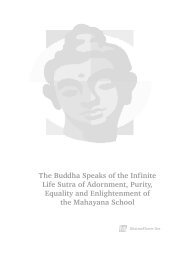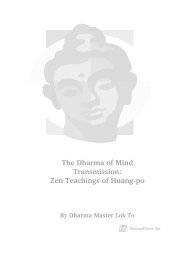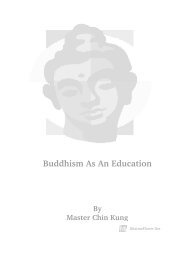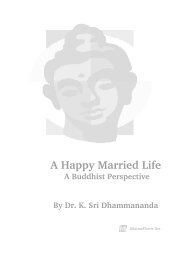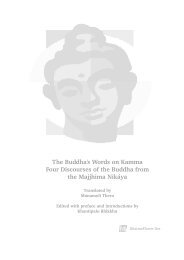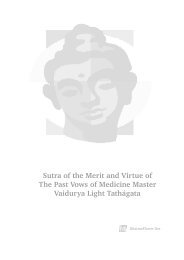Vipassana Meditation : Lectures On Insight Meditation by Venerable
Vipassana Meditation : Lectures On Insight Meditation by Venerable
Vipassana Meditation : Lectures On Insight Meditation by Venerable
You also want an ePaper? Increase the reach of your titles
YUMPU automatically turns print PDFs into web optimized ePapers that Google loves.
passing away. but he must strive with padhana (strong and firm viriya oreffort) to meditate on mental and physical processes to attain the fourth stageof insight knowledge, i.e. Udayabbaya-nana, knowledge of arising and passingaway. If a meditator possesses wisdom he is sure to make progress until heattains at least the lowest Path Knowledge - Sotapatti-magga-nana. That is whythe Buddha said that a meditator must possess wisdom, which realizes theappearance and disappearance of mental and physical phenomena. So theseare the five factors, which a meditator must have.When a meditator has attained Sotapatti-magga-nana, the first stage ofenlightenment, he has uprooted both the concept of a soul or a self,personality or individuality (sakkaya-ditthi) and doubt (vicikiccha) about theTriple Gem. When a meditator has attained purification of mind, his mindbecomes sharp enough to penetrate into the true nature of the mind-bodyprocesses. Then he distinguishes between the mental and physical processesand realizes the specific characteristics of mental and physical phenomena.This is the first stage of insight. When he can realize the specific characteristicsof mental and physical phenomena and can distinguish between nama andrupa, he can destroy sakkaya-ditthi and atta-ditthi for the time being. At thisstage of insight, he has uprooted sakkaya-ditthi and atta-ditthi. When he is notexperiencing this insight, sakkaya ditthi and atta-ditthi will come back to him,although not strongly. Sakkaya-ditthi is only uprooted or exterminated <strong>by</strong>attaining the first stage of enlightenment, Sotapatti-magga- nana.Attá in BrahmanismWe should understand the concepts of sakkaya-ditthi and atta-ditthi from thepoint of view of Hinduism.According to Hinduism or Brahmanism, the whole world was created <strong>by</strong>Maha-Brahma. This Mahabrahmahas many names such as, Isvara,Paramatmaand Prajapati. 'Pati' means creator or master. Prajameans creaturesor living beings. So he is the master of living beings because he created them.Paramatma is a Sanskrit or Hindu term. In Pali it is Paramatta. When wedivide this Paramatma into two words, it is Parama and atma. Here paramameans the noblest, the holiest; 'atma' means soul or self. So Paramatma meansthe holiest soul. Some translate this word as the big self or big soul. This soulis big enough to create the world and living beings. When the condition of theworld was good enough for living beings to live in, he created all living beingsmen,decas, Brahmas, and animals. He even created tigers, lions and poisonoussnakes, which are a great danger to man. When Maha-Brahma or Paramatmafirst created living beings, they were like corpses; they could not move, sit orstand. Then Maha-Brahma wanted to make these creatures come to life. So heput a soul into each creature or living being. Then all the creatures got up andmoved stood, sat and so on. In this way, that small soul or self existed in everyliving being according to Brahmanism. Even an insect has a small soul in it.45



